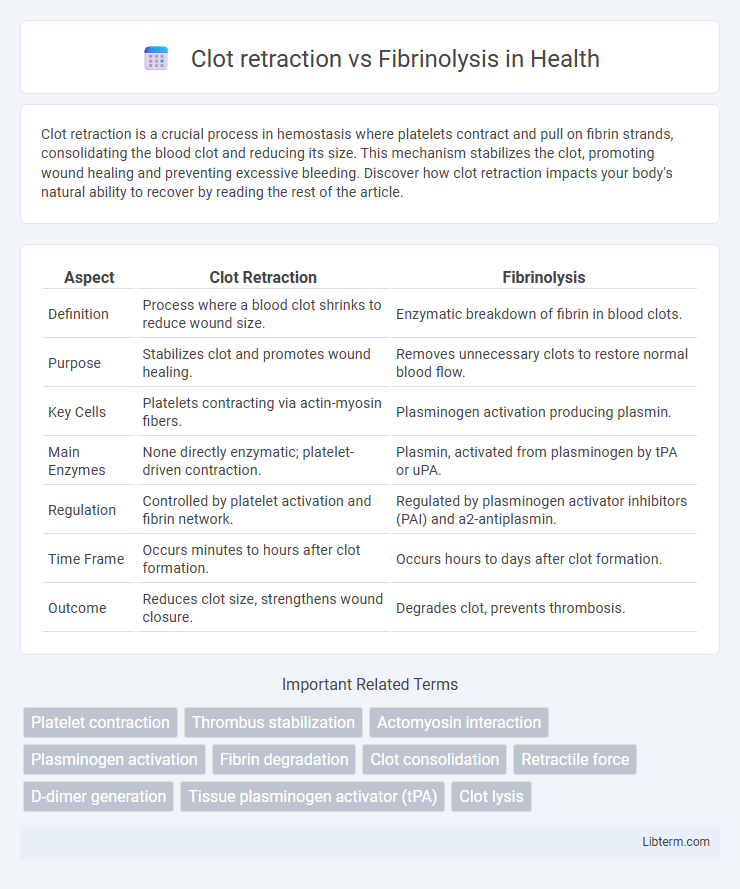Clot retraction is a crucial process in hemostasis where platelets contract and pull on fibrin strands, consolidating the blood clot and reducing its size. This mechanism stabilizes the clot, promoting wound healing and preventing excessive bleeding. Discover how clot retraction impacts your body's natural ability to recover by reading the rest of the article.
Table of Comparison
| Aspect | Clot Retraction | Fibrinolysis |
|---|---|---|
| Definition | Process where a blood clot shrinks to reduce wound size. | Enzymatic breakdown of fibrin in blood clots. |
| Purpose | Stabilizes clot and promotes wound healing. | Removes unnecessary clots to restore normal blood flow. |
| Key Cells | Platelets contracting via actin-myosin fibers. | Plasminogen activation producing plasmin. |
| Main Enzymes | None directly enzymatic; platelet-driven contraction. | Plasmin, activated from plasminogen by tPA or uPA. |
| Regulation | Controlled by platelet activation and fibrin network. | Regulated by plasminogen activator inhibitors (PAI) and a2-antiplasmin. |
| Time Frame | Occurs minutes to hours after clot formation. | Occurs hours to days after clot formation. |
| Outcome | Reduces clot size, strengthens wound closure. | Degrades clot, prevents thrombosis. |
Introduction to Clot Retraction and Fibrinolysis
Clot retraction is the process by which a blood clot becomes more compact and stable as platelets contract and pull on the fibrin meshwork. Fibrinolysis is the enzymatic breakdown of fibrin in blood clots, primarily mediated by plasmin to restore normal blood flow. Both mechanisms play critical roles in hemostasis, with clot retraction stabilizing the clot and fibrinolysis enabling clot resolution and tissue repair.
Definition of Clot Retraction
Clot retraction is the process by which a blood clot contracts and shrinks after formation, driven primarily by platelets pulling on fibrin strands to stabilize the clot and reduce its size. This mechanical tightening helps to bring wound edges closer together and promotes tissue repair. In contrast, fibrinolysis is the biochemical breakdown of the fibrin mesh by plasmin, leading to clot dissolution and restoration of normal blood flow.
Definition of Fibrinolysis
Fibrinolysis is the biological process that breaks down fibrin in blood clots, restoring normal blood flow and preventing excessive clot formation. It involves the activation of plasminogen to plasmin, which enzymatically degrades the fibrin mesh within the clot. Unlike clot retraction, which physically reduces clot size through platelet contraction, fibrinolysis dissolves the clot chemically by enzymatic degradation.
Mechanisms Involved in Clot Retraction
Clot retraction involves the contraction of the fibrin mesh driven by activated platelets using actin and myosin to pull fibrin fibers closer, stabilizing the thrombus and reducing its size. This process is mediated by integrin aIIbb3 binding to fibrin and requires ATP for platelet cytoskeletal rearrangement. In contrast, fibrinolysis is the enzymatic breakdown of fibrin by plasmin, dissolving clots to restore normal blood flow.
Mechanisms Involved in Fibrinolysis
Fibrinolysis involves the enzymatic breakdown of fibrin clots primarily mediated by plasmin, a serine protease activated from plasminogen by tissue plasminogen activator (tPA) and urokinase plasminogen activator (uPA). This process degrades the fibrin mesh, leading to clot dissolution and restoration of normal blood flow. Unlike clot retraction, which mechanically compacts the clot through platelet contraction, fibrinolysis enzymatically degrades the clot structure to prevent excessive thrombosis.
Key Differences Between Clot Retraction and Fibrinolysis
Clot retraction involves the contraction of a blood clot by platelets to reduce its size and stabilize the wound site, primarily mediated by actin and myosin within platelets. Fibrinolysis is the enzymatic breakdown of fibrin in the clot, facilitated by plasmin, which dissolves the clot to restore normal blood flow after tissue repair. The key difference lies in clot retraction enhancing clot stability and fibrinolysis promoting clot removal and vascular healing.
Physiological Significance of Clot Retraction
Clot retraction plays a crucial physiological role by consolidating the platelet plug, reducing wound size, and stabilizing the clot to prevent excessive bleeding. It facilitates the restoration of blood flow around the injury site by compressing the fibrin mesh, which contrasts with fibrinolysis that actively breaks down the clot during tissue repair. This process is essential for effective hemostasis, promoting tissue healing and minimizing the risk of thrombosis.
Physiological Importance of Fibrinolysis
Fibrinolysis plays a crucial physiological role by breaking down fibrin clots to restore normal blood flow and prevent vessel occlusion after tissue repair. Unlike clot retraction, which compacts and stabilizes the clot to facilitate wound healing, fibrinolysis ensures the removal of excessive fibrin to maintain vascular patency and prevent thrombosis. Efficient fibrinolytic activity balances clot formation and dissolution, critical for hemostatic regulation and preventing pathological clot persistence.
Clinical Implications and Disorders
Clot retraction, essential for wound healing, involves platelet contraction shrinking the clot, while fibrinolysis breaks down the clot to restore vessel patency; disorders like impaired clot retraction can lead to bleeding tendencies, whereas excessive fibrinolysis may cause hemorrhage. Clinical implications include monitoring for platelet function defects in diseases such as Glanzmann thrombasthenia and managing fibrinolytic activity in conditions like disseminated intravascular coagulation (DIC). Therapies targeting these processes, including antifibrinolytics or platelet transfusions, are critical in controlling bleeding or thrombotic risks.
Summary: Clot Retraction vs Fibrinolysis
Clot retraction involves the contraction of a formed blood clot, driven by platelets and intracellular actin-myosin interactions, which stabilizes the clot and reduces its size to facilitate vessel repair. Fibrinolysis is the enzymatic breakdown of fibrin within the clot, primarily mediated by plasmin, leading to clot dissolution and restoration of normal blood flow. These processes serve complementary roles: clot retraction supports wound healing by compacting the clot, while fibrinolysis removes the clot once vessel repair is complete.
Clot retraction Infographic

 libterm.com
libterm.com